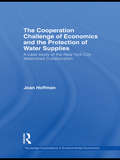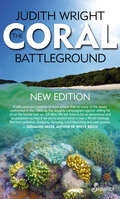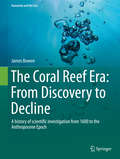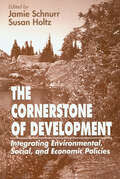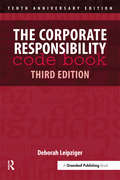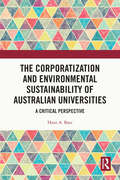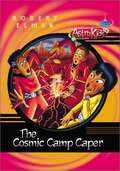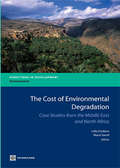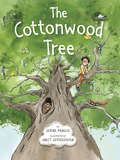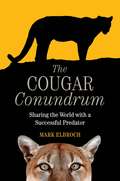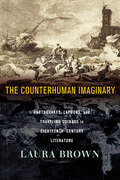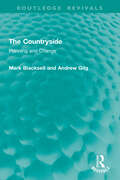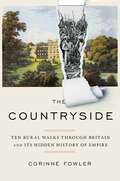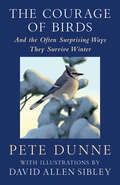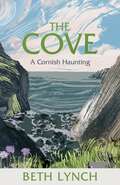- Table View
- List View
The Cooperation Challenge of Economics and the Protection of Water Supplies: A Case Study of the New York City Watershed Collaboration (Routledge Explorations In Environmental Economics Ser.)
by Joan HoffmanHow can we build the institutions that will promote the cooperation needed to meet our intertwined environmental and economic needs? Efforts to meet these twin goals in New York City’s watershed collaborations offer some guidance. The experience provides lessons in addressing scattered sources of pollution, encouraging environmentally compatible economic development, and coping with conflicts that are part of the collaboration process. It also yields insights into what we need to work effectively towards sustainable economic development. This book identifies many barriers to achieving the cooperation necessary to solving our water problems and discusses how watershed collaborations are a means to overcoming those barriers. Historical experience and lessons from other watershed collaborations informed the design of New York City’s complex watershed collaboration which is shown to contain the elements of a "green milieu" that can foster sustainable economic development. The particular challenges to the collaboration’s environmental and economic goals created by the watershed’s rural economy, farming and forestry are described. The unusual inclusion of the analysis of the economic aspects and effects of collaboration, of the relationship between collaboration and sustainable development, and of the processes of implementation and conflict make this book especially valuable to those interested in collaboration, regulation, environmental cooperation and conflict, watershed protection, economic development in general, and sustainable economic development in particular.
The Coral Battleground
by Judith WrightThe Great Barrier Reef lies off the coast of Queensland: 2000 kilometres of spectacular coral reefs, sand cays and islands, Australia's most precious marine possession. Teeming with life, it covers 350,000 square kilometres. In the late 1960s the Reef was threatened with limestone mining and oil drilling. A small group of dedicated conservationists in Queensland - John Büsst, Judith Wright, Len Webb and others - battled to save the Ellison Reef from coral-limestone mining and the Swain Reefs from oil exploration. The group later swelled to encompass scientists, trade unionists and politicians throughout Australia, and led in 1976 to the establishment of a guardian body: the Great Barrier Reef Marine Park Authority.That it still survives is a legacy of activists, artists, poets, ecologists and students. In 1967 they were branded as 'cranks'; now they should be recognised as 'visionaries'.
The Coral Reef Era: From Discovery to Decline
by James BowenOn 4 June 1629, the Batavia, pride of the Dutch East India Company Fleet, was wrecked on her maiden voyage in a seemingly empty expanse of the Indian Ocean. The question "how did this happen?" led to 300 years of investigation by those curious to solve the enigma: what are corals and how are coral reefs formed?. Relying heavily on primary source material Part 1 traces the sequential evolution of scientific thought and practice as the author explores the way this evolution is reflected in the search for understanding corals. At each stage, answers lead to fresh questions that challenge investigators to solve the riddle and new branches of science emerge. Then, with the first enigma finally understood, a new enigma arose. Why are Reefs dying? Part 2 traces the range of problems that have emerged in the past 50 years as marine, ecological, reef and climate scientists attempt to put the pieces of the jigsaw together. Is there a new "canary in the coal mine" warning of the fate of the world as we know it if man's impact on his environment continues unchecked?.
The Cornerstone of Development: Integrating Environmental, Social, and Economic Policies
by Jamie Schnurr 0 Idrc Susan Holtz Greg Armstrong Anne K Bernard"Sustainable development" quickly became the universal goal for environmentalists in the 1990s, motivated by the 1988 Brundtland Report and the 1992 Earth Summit in Rio. When the time came to bring theory into reality, sustainable development revealed far more complexity than first anticipated.To attain sustainable development in the full sense of the phrase"meeting present needs without compromising the resources needed for future societies"environmental and social concerns would need a constant presence in all major economic decisions.The Cornerstone of Development: Balancing Environmental, Social, and Economic Imperatives profiles many of the first attempts to implement sustainable development initiatives worldwide. The model: Canada's experience with "multistakeholder" decision-making. Under the guidance of Canada's National Task Force on Environment and Economy, nationwide and provincial round tables brought government officials together with corporate officers to formulate sustainable development guidelines.Authorized by the Canadian government to serve as an "Agenda 21 organization," the International Development Research Centre (IDRC) subsequently researched the feasibility of adapting the multistakeholder approach to the needs and practices of developing countries. The results are in these pages: valuable case histories from Africa, Latin America, Asia and Canada, each recounting the risks and benefits from integrating environmental, social and economic policies.When IDRC members were asked for ways to address environmental sustainability, they had few examples to follow"and little evidence that such endeavors could be fulfilled. The research and problem-solving efforts they produced are now collected here, for the guidance of other environment/development balance programs worldwide.
The Corporate Reapers: The Book of Agribusiness
by A. V. KrebsLearn more about the business of food, and the pressures placed on family farmers by industrial agribusiness.
The Corporate Responsibility Code Book
by Deborah LeipzigerThe Corporate Responsibility Code Book has become the go-to guide for companies trying to understand the landscape of corporate responsibility and searching for their own, unique route towards satisfying diverse stakeholders. There is no one-size-fits-all approach. A company may face quite different challenges if it operates in more than one part of the world. And yet stakeholders, especially consumers and investors, are keen for some degree of comparability with which they can evaluate corporate performance. There are countervailing forces at work within corporate responsibility: on the one hand is the need for convergence in order to simplify the large numbers of codes and standards; and, on the other hand, the need to foster diversity and innovation.Many of the best codes of conduct and standards are not well known, while some CR instruments that are well disseminated are not terribly effective. Some comprehensive codes of conduct achieve nothing, while other quite vague codes of conduct become well embedded into the organization and foster innovation and change. This landmark book explains the best CR instruments available, and distils their most valuable elements.In the fully revised third edition, Deborah Leipziger widens her lens to provide detailedanalysis of the UN Guiding Principles on Business and Human Rights, the Gender EqualityPrinciples and ISO 26000 while updating other key tools such as the Equator Principles, the OECD guidelines and GRI’s new G4 framework.The codes in this book cover a wide range of issues, including human rights, labour rights,environmental management, corruption and corporate governance. The book also includeshow-to (or process) codes focusing on reporting, stakeholder engagement and assurance.
The Corporatization and Environmental Sustainability of Australian Universities: A Critical Perspective
by Hans BaerAnalysing the juxtaposition of two trends in universities – corporatisation and environmental sustainability – this book explores how they are more contradictory than compatible. Hans A Baer argues that this contradiction is unavoidable because of the capitalist parameters in which they operate, including a commitment to on-going economic growth which contributes to social inequality, environmental degradation, and greenhouse gas emissions. Drawing on archival sources and Baer’s experiences in university sustainability forums, the book exposes how what universities claim to do in relation to environmental sustainability compares with their research, educational, operational and institutional activities. Presenting a critique of and a radical alternative to the status quo, this book is suitable for academics and students of anthropology, environmental studies and higher education.
The Corporatization and Environmental Sustainability of Australian Universities: A Critical Perspective
by Hans BaerAnalysing the juxtaposition of two trends in universities – corporatisation and environmental sustainability – this book explores how they are more contradictory than compatible.Hans A Baer argues that this contradiction is unavoidable because of the capitalist parameters in which they operate, including a commitment to on-going economic growth which contributes to social inequality, environmental degradation, and greenhouse gas emissions. Drawing on archival sources and Baer’s experiences in university sustainability forums, the book exposes how what universities claim to do in relation to environmental sustainability compares with their research, educational, operational and institutional activities.Presenting a critique of and a radical alternative to the status quo, this book is suitable for academics and students of anthropology, environmental studies and higher education.
The Correspondence Of Charles Darwin: Volume 20 1872
by Janet Browne Frederick Burkhardt James A. Secord Samantha Evans Shelley Innes Francis Neary Alison M. Pearn Anne Secord Paul WhiteThis volume is part of the definitive edition of letters written by and to Charles Darwin, the most celebrated naturalist of the nineteenth century. Notes and appendixes put these fascinating and wide-ranging letters in context, making the letters accessible to both scholars and general readers. Darwin depended on correspondence to collect data from all over the world, and to discuss his emerging ideas with scientific colleagues, many of whom he never met in person. The letters are published chronologically: volume 20 includes letters from 1872, the year in which The expression of the emotions in man and animals was published, making ground-breaking use of photography. Also in this year, the sixth and final edition of On the origin of species was published, and Darwin resumed his work on carnivorous plants and plant movement, finding unexpected similarities between the plant and animal kingdoms.
The Correspondence of Charles Darwin
by Frederick Burkhardt James A. SecordOver 850 letters between Darwin and worldwide correspondents, as he gathered information on human origins and the expression of emotion.
The Correspondence of Charles Darwin 1877: VOLUME 25 (The Correspondence of Charles Darwin)
by Frederick Burkhardt James A. SecordThis volume is part of the definitive edition of letters written by and to Charles Darwin, the most celebrated naturalist of the nineteenth century. Notes and appendixes put these fascinating and wide-ranging letters in context, making the letters accessible to both scholars and general readers. Darwin depended on correspondence to collect data from all over the world, and to discuss his emerging ideas with scientific colleagues, many of whom he never met in person. The letters are published chronologically: volume 25 includes letters from 1877, the year in which Darwin published Forms of Flowers and with his son Francis carried out experiments on plant movement and bloom on plants. Darwin was awarded an honorary LL. D. by Cambridge University, and appeared in person to receive it. The volume contains a number of appendixes, including two on the albums of photograph sent to Darwin by his Dutch, German, and Austrian admirers.
The Correspondence of Charles Darwin: VOLUME 24
by Frederick Burkhardt James A. SecordThis volume is part of the definitive edition of letters written by and to Charles Darwin, the most celebrated naturalist of the nineteenth century. Notes and appendixes put these fascinating and wide-ranging letters in context, making the letters accessible to both scholars and general readers. Darwin depended on correspondence to collect data from all over the world, and to discuss his emerging ideas with scientific colleagues, many of whom he never met in person. The letters are published chronologically: volume 24 includes letters from 1876, the year in which Darwin published Cross and Self Fertilisation in the Vegetable Kingdom, and started writing Forms of Flowers. In 1876, Darwin's daughter-in-law, Amy, died shortly after giving birth to a son, Bernard Darwin, an event that devastated the family. The volume includes a supplement of 182 letters from earlier years, including a newly discovered collection of letters from William Darwin, Darwin's eldest son.
The Corvette
by Richard WoodmanRewarded by promotion for his services at the Battle of Copenhagen, Commander Drinkwater is dispatched in haste by Earl St. Vincent to replace the captain of HMS Mdusine, who has been shot in a duel.
The Cosmic Camp Caper (AstroKids #6)
by Robert ElmerThe gang thought they would be roasting marshmallows over miniature volcanoes and practicing laser archery, but instead, Camp Little Dipper proves to be something else entirely. Book 6 of AstroKids.
The Cost of Being Landlocked: Logistics, Costs, and Supply Chain Reliability
by Gaël Raballand Jean-François Marteau Jean-François Arvis'The Cost of Being Landlocked' proposes a new analytical framework to interpret and model the constraints faced by logistics chains on international trade corridors. The plight of landlocked developing countries (LLDCs) has naturally received special attention for decades, leading to a specific set of development priorities based upon the concept of dependence on the transit state. Therefore, the standard approach used to tackle the cost of being landlocked has been predominantly aimed at developing regional transport infrastructure and ensuring freedom of transit through regional conventions. But without sufficient attention given to the performance of logistics service delivery to traders, the standard approach is unable to address key bottleneck concerns and the factors that contribute to the cost of being landlocked. Consequently, the impact of massive investment on trade corridors could not materialize to its full extent. Based on extensive data collection in several regions of the world, this book argues that although landlocked developing countries do face high logistics costs, these costs are not a result of poor road infrastructure, since transport prices largely depend on trucking market structure and implementation of transit processes. This book suggests that high logistics costs in LLDCs are a result of low logistics reliability and predictability, which stem from rent-seeking and governance issues. 'The Cost of Being Landlocked' will serve as a useful guide for policy makers, supervisory authorities, and development agencies.
The Cost of Environmental Degradation
by Lelia Croitoru Maria SarrafHow much is a cleaner environment worth? For policy makers, that question used to go largely unanswered. Many economic activities cause environmental degradation, entailing real costs to the economy and to people's welfare. Knowing the extent of these costs is crucial for identifying a country's main environmental priorities and allocating appropriate funds for environmental protection. Over the past decade, the World Bank has initiated a systematic effort to measure the costs of environmental degradation in the Middle East and North Africa, shedding new light on their magnitude and on the need for policy changes. In many cases, these costs were found to be surprisingly large. 'The Cost of Environmental Degradation: Case Studies from the Middle East and North Africa' brings together the best case studies of this program and summarizes their policy impacts at the national and regional levels. The case studies quantify monetarily the annual damage due to environmental degradation and express these estimates as percentages of the countries' gross domestic product. The studies use the most recent environmental valuation methods to estimate the economic costs resulting from air pollution, water degradation, deforestation, and land degradation. Uniquely, the book dedicates a case study to value the costs of environmental degradation resulting from an oil spill and demolition waste in times of conflict. The studies then illuminate the concrete implications on policy, investments, and institutions for the respective nations. This book will be of interest to policy makers, nongovernmental organizations, and academic and research institutions.
The Costs of the Common Agricultural Policy (Routledge Library Editions: Agriculture #7)
by Kenneth J. Thomson Allan E. Buckwell David R. Harvey Kevin A. PartonFirst published in 1982. Considerable public controversy surrounded the large amount of public expenditure devoted to agriculture under the European Community’s Common Agricultural Policy (CAP). There were serious disputes over how the farm support system operated and how it was financed. This book describes the CAP situation and summarises previous attempts to assess some of the economic and financial flows arising from its creation using a common framework of well-established economic theory and methods. The CAP turned out to have a number of ‘costs’, depending on the concept of ‘cost’ used, the alternative policies considered, and the various assumptions made. The bulk of the book presents the structure and results of a comprehensive model of European Community agricultural markets and the associated CAP support mechanisms. This model is validated against official Community budget figures and then run to simulate a number of policy options and their consequences. This title will be of interest to students of economics, geography and agriculture.
The Cottonwood Tree
by Serena MangusCottonwood trees grow throughout North America and play a critical role in their ecosystems, yet little has been written about them. In this “autobiography,” a cottonwood tree tells its life story beginning when it is only a seed in a bed of fluff, floating over a river somewhere in the American heartland, and ending more than 80 years later when it is toppled by a fierce storm. Along the way the seed grows into a majestic tree, spreading its life-giving branches to birds, insects, and animals. The tree recounts its visits over the years by a special human who was born in the same year. As a boy, this human climbs the cottonwood’s branches to watch the river and dream. As a father, he brings his daughter to visit. As an old man he grieves to see the tree knocked down but rejoices when he sees new sprouts emerging from the stump. He knows the tree is not done yet! Captions throughout the book relate the natural histories of animals in and around the tree, and the backmatter offers further resources.
The Cougar Conundrum: Sharing the World with a Successful Predator
by Mark ElbrochThe relationship between humans and mountain lions has always been uneasy. A century ago, mountain lions were vilified as a threat to livestock and hunted to the verge of extinction. In recent years, this keystone predator has made a remarkable comeback, but today humans and mountain lions appear destined for a collision course. Its recovery has led to an unexpected conundrum: Do more mountain lions mean they're a threat to humans and domestic animals? Or, are mountain lions still in need of our help and protection as their habitat dwindles and they're forced into the edges and crevices of communities to survive? Mountain lion biologist and expert Mark Elbroch welcomes these tough questions. He dismisses long-held myths about mountain lions and uses groundbreaking science to uncover important new information about their social habits. Elbroch argues that humans and mountain lions can peacefully coexist in close proximity if we ignore uninformed hype and instead arm ourselves with knowledge and common sense. He walks us through the realities of human safety in the presence of mountain lions, livestock safety, competition with hunters for deer and elk, and threats to rare species, dispelling the paranoia with facts and logic. In the last few chapters, he touches on human impacts on mountain lions and the need for a sensible management strategy. The result, he argues, is a win-win for humans, mountain lions, and the ecosystems that depend on keystone predators to keep them in healthy balance. The Cougar Conundrum delivers a clear-eyed assessment of a modern wildlife challenge, offering practical advice for wildlife managers, conservationists, hunters, and those in the wildland-urban interface who share their habitat with large predators.
The Counterhuman Imaginary: Earthquakes, Lapdogs, and Traveling Coinage in Eighteenth-Century Literature
by Laura BrownThe Counterhuman Imaginary proposes that alongside the historical, social, and institutional structures of human reality that seem to be the sole subject of the literary text, an other-than-human world is everywhere in evidence. Laura Brown finds that within eighteenth-century British literature, the human cultural imaginary can be seen, equally, as a counterhuman imaginary—an alternative realm whose scope and terms exceed human understanding or order.Through close readings of works by Daniel Defoe, Jonathan Swift, and Alexander Pope, along with lapdog lyrics, circulation narratives that give agency to inanimate objects like coins and carriages, and poetry about the Lisbon earthquake of 1755, Brown traces the ways presence and power of the nonhuman—weather, natural disasters, animals, even the concept of love—not only influence human creativity, subjectivity, and history but are inseparable from them. Traversing literary theory, animal studies, new materialism, ecocriticism, and affect theory, The Counterhuman Imaginary offers an original repudiation of the centrality of the human to advance an integrative new methodology for reading chaos, fluidity, force, and impossibility in literary culture.
The Countryside: Planning and Change (Routledge Revivals)
by Andrew Gilg Mark BlacksellThe Countryside: Planning and Change (1981) examines the relationship between policies and their actual effects on the countryside, throwing light on the problems inherent in a fragmented approach to policy-making. It looks at the underlying reasons for change in the rural environment first and then the governmental response as reflected in powers assumed and rights granted to guide and direct rural development. The way in which land-use changes have been affected by public policies is then examined in further detail, with particular attention to settlements. Detailed case studies are utilised for this purpose.
The Countryside: Ten Rural Walks Through Britain and Its Hidden History of Empire
by Corinne FowlerTen walks through idyllic scenery reveal the countryside&’s forgotten links to transatlantic slavery and colonialism—a work of accessible history that will transform our understanding of British landscapes and heritage.The green fields, rugged highlands, and rolling hills of England, Scotland, and Wales are commonly associated with adventure, romance, and seclusion as well as literary figures like Jane Austen and William Wordsworth. But in reality, many of these rural places—with their country houses, lakes, and shorelines—were profoundly changed by British colonial activity. Even hamlets and villages were affected by distant colonial events. Taking ten country walks, author Corinne Fowler explores the unique colonial dimensions of British agriculture, copper-mining, landownership, wool-making, coastal trade, and factory work in cotton mills. One route shows the links between English country houses and Indian colonization. Another explores banking history in Southern England and its link to slavery on Louisianan plantations. Other walks uncover the historical impact of sugar profits on the Scottish isles and 18th-century tobacco imports on an English coastal port. The history of these countryside locations—and the people who lived and worked in them—is closely bound up with colonial rule in far-away continents. Accompanying the author on her walks are a fascinating group of people—artists, musicians, and writers—with strong attachments to the landscapes featured in this book and family links to former British colonies like Barbados and Senegal. These companions illuminate the meaning of colonial history in local settings. Crucially, this is not just a history book but a compassionate reflection on the way we respond to sensitive, shared histories which link people across cultures, generations, and political divides.
The Courage of Birds: And the Often Surprising Ways They Survive Winter
by Pete DunneFrom our own backyards to the rim of the Arctic ice, countless birds have adapted to meet the challenges of the winter season. This is their remarkable story, told by award-winning birder and acclaimed writer Pete Dunne, accompanied by illustrations from renowned artist and birder David Sibley.Despite the seasonal life-sapping cold, birds have evolved strategies that meet winter&’s vicissitudes head on, driven by the imperative to make it to spring and pass down their genes to the next generation. The drama of winter and the resilience and adaptability of birds witnessed in the harsher months of the calendar is both fascinating and astonishing.In The Courage of Birds, Pete Dunne—winner of the American Birding Association&’s Roger Tory Peterson Award for lifetime achievement in promoting the cause of birding—chronicles the behavior of the birds of North America. He expertly explores widespread adaptations, such as feathers that protect against the cold, and unpacks the unique migration patterns and survival strategies of individual species. Dunne also addresses the impact of changing climatic conditions on avian longevity and recounts personal anecdotes that soar with a naturalist&’s gimlet eye.Filled with unforgettable facts, wit, and moving observations on the natural world, Dunne&’s book is for everyone; from the serious birder who tracks migration patterns, to the casual birder who logs daily reports on eBird, to the backyard observer who throws a handful of seed out for the Northern Cardinals and wonders how the birds magically appear in the garden when temperatures begin to fall.Praise for Pete Dunne&“Dunne&’s prose is lyrical, sensitive, and full of feeling.&”—Ted Floyd, editor, Birding &“Pete is arguably North America&’s best and best-known birder—and he&’s also a terrific writer.&”—Scott Shalaway, author and former syndicated nature columnistPraise for David Sibley&“There are 47 million birdwatchers. But there is only one David Sibley. . . . He is a boon to both the birding world and the art world.&”—The National Audubon Society&“[His] exacting artwork and wide-ranging expertise bring observed behaviors vividly to life.&”—Birdwatching
The Cove: A Cornish Haunting
by Beth LynchFor over five decades Beth Lynch has been drawn back, over and again, to a rocky spot on the North Cornwall coast. Her earliest memories of the cove are bound up with idyllic family holidays; as she grows older, however, her sense of connection with the place grows deeper and more complicated. This slippery interface of land and sea - a site of sheer edges and ledges, peculiar rock formations and eroding, tumbling slate - becomes her childhood refuge from anxiety and school bullying.Around the time of her parents' deaths, strange things start to happen in and around the cove, and Lynch is left wondering how well she really knows this minute section of coast that draws her so ineluctably. Is it the cove, or is it her? What secrets does the cove have to share? Is she safer staying away? Unfolding through a medium of salt and slate, the elemental indifference of Atlantic Cornwall, The Cove is a lyrical meditation on being a revenant, on haunting and being haunted. Through encounters with quarrymen, wartime women and a enigmatic archaeologist - along with JMW Turner, Alfred, Lord Tennyson, Anthony Trollope, and Thomas and Emma Hardy - Lynch contemplates what happens when our deepest fears materialise, reflecting on mortality and the nuanced ways in which we take leave of our dead. She explores the profound impacts of change - in ourselves, in places and in the transformative dance between the two.
